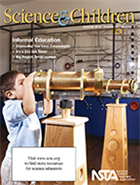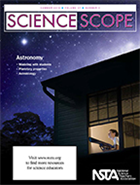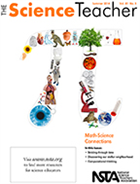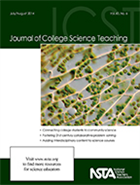NSTA’s K-College Science Education Journals: July 2014 Issues Online
By Lauren Jonas, NSTA Assistant Executive Director
Posted on 2014-07-03
Science teachers get a break from lesson planning this month, so it’s a nice time to ponder other questions: What informal science experiences are valuable for elementary students? Can middle school students discuss whether or not we are alone in the universe? How do you align mathematics and science at the high school level? Can you integrate social media into the college classroom? Your peers are sharing great ideas in this month’s K–College journals from the National Science Teachers Association. Take time to read some of the articles below, and explore science heroes, STEAM, the “dark side of the tube,” and molecular modeling.
 Science and Children
Science and Children
There are many valuable science education resources outside of the classroom. When these are supported by school and home experiences, the impact can be far-reaching. This issue of Science and Children will help you make the most of informal science experiences with your students.
Featured articles (please note, only those marked “free” are available to nonmembers with out a fee):
- A Healthful Balance
- Assessments in the Arguments
- Free – Editor’s Note: Building Language for Science Literacy
- Friction in Different Languages
- Free – Guest Editorial: The BSCS 5E Instructional Model: Personal Reflections and Contemporary Implications
- Free – Observe, Explain, Connect
- Putting the “Her” in Science Hero
- Full Table of Contents
 Science Scope
Science Scope
Humans have always been fascinated by the ever-changing night sky and have spent many hours pondering its mysteries. Are we alone in the universe? What would it be like to live on another planet? Why does the night sky change? Explore these and other big questions with the help of this issue of Science Scope, which features lessons about planetary properties, developing student-centric astronomical models, and extreme environments on our planet and beyond.
Featured articles (please note, only those marked “free” are available to nonmembers without a fee):
- Free – Astrobiology: Explorations in Earth and Life Science
- Born to Run: Experimental Evolution of High Voluntary Exercise in Mice
- Free – Editor’s Roundtable: Adding some STEAM to Astronomy
- Including Students in a Model of the Earth, Moon, and Sun System
- Letters! We Get Letters
- Think Instruments, Think Apps: Using App-Based Technology in the Science Classroom
- Full Table of Contents
 The Science Teacher
The Science Teacher
Reform movements have long championed aligning mathematics and science education. Over more than three decades, various standards documents have extolled the potential synergy that can result when science investigations use mathematics. Now the Next Generation Science Standards (NGSS) extend these important math-science connections by identifying crosscutting concepts, scientific and engineering practices, and disciplinary core ideas important to both science and mathematics. The NGSS also make explicit connections to the Common Core State Standards in mathematics. The articles in this issue of The Science Teacher provide useful ideas about including mathematics in your science teaching.
- Computational Thinking in High School Science Classrooms
- Discovering Our Stellar Neighborhood
- Free – Editor’s Corner: Math-Science Connections
- Graphing the Past
- Striding Through Time
- Free – The Dark Side of the Tube
- Full Table of Contents
 Journal of College Science Teaching
Journal of College Science Teaching
Can social media be successfully integrated into the higher education classroom as an additional information source? Read one study that evaluates the benefits of including Twitter in a semester course to disseminate relevant information and serve as a discussion tool. Also read how two authors used a version of the Jeopardy game in a second-semester general chemistry course to engage students, review the previous semester’s content, and set expectations for the new semester. And in the Two-Year Community column read about the effects of different teaching methods—lecture, blended, and hybrid—on students enrolled in a general biology course with laboratory for majors in a community college.
Featured articles (please note, only those marked “free” are available to nonmembers without a fee):
- A Learner-Centered Molecular Modeling Exercise for Allied Health Majors in a Biochemistry Class
- A Novel Interdisciplinary Science Experience for Undergraduates Across Introductory Biology, Chemistry, and Physics Courses
- Applying the Brakes: How Practical Classroom Decisions Affect the Adoption of Inquiry Instruction
- Beginning a Classroom Inquiry: Using Photovoice to Connect College Students to Community Science
- Collaborative Projects Increase Student Learning Outcome Performance in Nonmajors Environmental Science Course
- Free – Editorial: Bully for You
- General Chemistry II: Setting the Stage on the First Day With Jeopardy
- Research and Teaching: Fostering Collaborative Problem Solving and 21st Century Skills Using the DEEPER Scaffolding Framework
- Research and Teaching: Published Freshman Lab Exercises as Indicators of Awareness and Adoption of Instructional Practices Grounded in Discipline-Based Education Research
- Free – Twitter in the Higher Education Classroom: A Student and Faculty Assessment of Use and Perception
- Full Table of Contents
Disclaimer: The views expressed in this blog post are those of the author(s) and do not necessarily reflect the official position of the National Science Teaching Association (NSTA).


